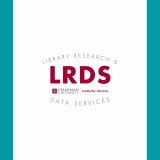My Librarian’s Favorite Resource(s): History
February 11, 2021
In the first episode of our new blog series, “My Librarian’s Favorite Resource(s),” we’re chatting with Rand Boyd, who in addition to being the Special Collections Librarian, also serves as the subject liaison librarian for History and Holocaust Studies. Rand shares with us his favorite resources for helping students studying History:
“I have had the pleasure of serving the History Department and Holocaust Education as their subject liaison librarian for the last twelve years. I hope that I will continue assisting them for the next twelve years. My primary liaison responsibility is providing information literacy instruction and research assistance. I give undergraduate and graduate classes bibliographic instruction sessions and History majors Individual Research Consultations. I meet with every History major during their senior year at least once and give them a shortlist of resources associated with their senior thesis topic to help jump-start their research.
I have several favorite resources; one that I always recommend for students just starting their historical research is the History Study Center: https://chapman.libguides.com/history_study_center
This database is an online resource providing a vast collection of digitized primary and secondary sources to study history. It is suitable for a wide range of users, from high school students looking for quick and reliable facts on a historical topic, to researchers examining hard-to-find primary source texts.
History Study Center covers global history from ancient times to the present day. Contents include reference books, essays, journal articles, historical newspaper and magazine articles, maps, rare books, government documents, transcripts of historical speeches, images, and video clips. This resource provides over 40,000 documents and articles, with over 50 reference works, 3,000 images and links to 2,000 websites. One of this resource’s strengths is that it presents its search results as “Study Units,” which are groupings of primary, secondary, and tertiary sources on a given topic. The material ranges from scholarly articles, to maps, photographs, video, and other primary documents. This source will not satisfy all of the research needs for a History student but is a great place to begin their search if they are unsure of what is available on their topic.
One of the best databases that I have ever come across is free but very narrow in its coverage. It is The Proceedings of the Old Bailey, 1674-1913: http://www.oldbaileyonline.org/. This excellent database is a fully searchable collection of the largest body of texts detailing the lives of non-elite people ever published, containing 197,745 criminal trials held at London’s central criminal court from the 17th to the early 20th centuries. Besides access to the transcripts of every trial, the database’s strength lies in its comprehensive statistical analysis tools. Students can run detailed demographic studies, but the interface is very straightforward to use. I first came across this database for Professor Lee Estes, now retired, who taught a popular First-Year Focus Course on Victorian crime and society for several years.
One of the most popular and useful collections of resources by far is our ProQuest Historical Newspapers: https://chapman.libguides.com/az.php?t=23426. The newspapers in this collection include a wide variety of American viewpoints. The strength of using newspapers in historical research is their flexibility. Beyond the historical data found in the articles is the historical metadata that can be teased out of the newspapers as historical objects. The physical design of newspapers provides an exciting view into the contemporary culture beyond the data and opinions found in the text. Page layout, the use of headlines, photographs, political cartoons, letters to the editor, and op-ed pieces all provide additional information for the thoughtful researcher.
Researchers can find these three resources and many more at the History Research and Study Guide located here: https://chapman.libguides.com/history.”


